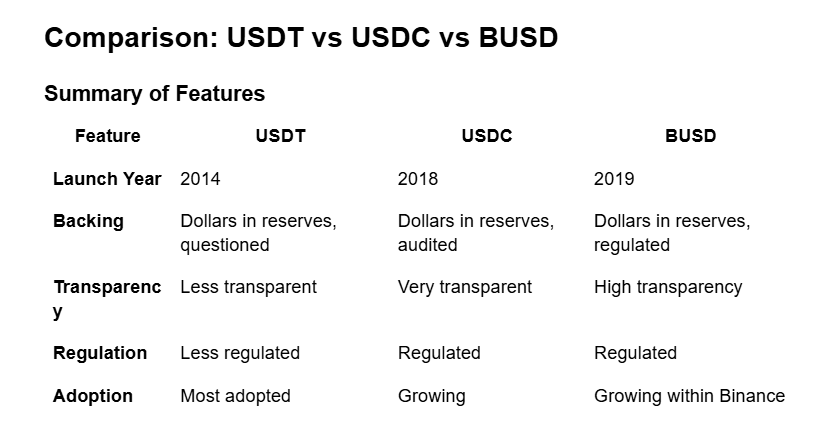In the vast world of cryptocurrencies, stablecoins have gained significant relevance. Among the most popular are USDT, USDC, and BUSD. But what are their similarities and differences? If you’re a beginner looking to better understand these cryptocurrencies, you’re in the right place! In this article, we will break down the characteristics of each one, their advantages and disadvantages, and how they can fit into your investment strategy.
Introduction to Stablecoins
Before diving into the differences and similarities between USDT, USDC, and BUSD, it’s essential to understand what stablecoins are. Stablecoins are cryptocurrencies designed to maintain a stable value, typically pegged to a fiat currency like the US dollar. This makes them ideal for those seeking stability in the highly volatile cryptocurrency market.
Why Are They Important?
Stablecoins allow users to transact without worrying about their investment's value fluctuating wildly. This is especially useful for those who want to protect their capital or make transactions within the crypto ecosystem. Now, let’s take a closer look at each of these stablecoins.
USDT (Tether)
What Is USDT?
USDT, or Tether, was one of the first stablecoins on the market. Launched in 2014, its goal was to provide a cryptocurrency that maintained a fixed value in relation to the US dollar. Each USDT is designed to be backed by one dollar in reserves.
Similarities and Differences with USDC and BUSD
Similarities:
- Objective: Like USDC and BUSD, its goal is to offer stability in a volatile market.
- Usage: It is widely used on exchanges and trading platforms.
Differences:
- Backing: Tether has faced criticism over the transparency of its reserves. Although it claims to be backed by one dollar for each USDT, there have been questions about the truth of these claims.
- Adoption: USDT is the most widely used stablecoin, but it has also been subject to stricter regulations in some places.
USDC (USD Coin)
What Is USDC?
USDC, launched in 2018, is a stablecoin issued by Circle and backed by the US dollar. Each USDC is fully backed by dollar reserves and is subject to monthly audits.
Similarities and Differences with USDT and BUSD
Similarities:
- Objective: Like USDT and BUSD, USDC aims to provide a stable value linked to the dollar.
- Use in DeFi: It is used in many decentralized finance (DeFi) applications.
Differences:
- Transparency: USDC is known for its higher level of transparency. Regular audits enhance user trust.
- Regulation: USDC complies with stricter regulations, which may appeal to users prioritizing legality and compliance.
BUSD (Binance USD)
What Is BUSD?
BUSD is a stablecoin issued by Binance, one of the largest cryptocurrency exchanges in the world. Launched in 2019, it is backed by the US dollar and regulated by the New York State Department of Financial Services (NYDFS).
Similarities and Differences with USDT and USDC
Similarities:
- Stability: BUSD, like USDT and USDC, maintains its value linked to the US dollar.
- Use in Trading: It is widely used in the Binance ecosystem for trading and transactions.
Differences:
- Regulation: Being regulated by NYDFS, BUSD has an additional level of trust that some users may value.
- Interoperability: BUSD can be used across various trading platforms and dApps, but its adoption is more prominent within the Binance ecosystem.

Practical Use of Each Stablecoin
- USDT: Ideal for traders looking for quick liquidity and access to multiple exchange platforms.
- USDC: A better option for those who value transparency and regular audits.
- BUSD: Perfect for users operating within the Binance ecosystem who want to comply with stricter regulations.
Which One Should You Choose?
Considerations for Beginners
If you’re a beginner, here are some things to consider when choosing between USDT, USDC, and BUSD:
- Transparency: If transparency is a concern for you, consider using USDC or BUSD, which offer audits and clear regulations.
- Usage: If you plan to trade primarily on Binance, BUSD may be the best option due to its integration with the platform.
- Liquidity: If you seek the highest liquidity, USDT remains the most popular option.
Usage Strategies
- Diversification: It’s a good idea to diversify among these stablecoins. Using multiple options can give you flexibility across different platforms and situations.
- Market Analysis: Stay informed about news and updates in the crypto world, as the regulation and perception of these stablecoins can change rapidly.
Conclusions
In summary, USDT, USDC, and BUSD are three of the most important stablecoins in the cryptocurrency market. Each has its unique characteristics, advantages, and disadvantages. By understanding their similarities and differences, you can make informed decisions about which one is the best fit for you, depending on your needs and goals as an investor.
Final Thoughts
As a beginner in the cryptocurrency world, it’s crucial to keep learning and exploring. Every day, the crypto ecosystem evolves, and new opportunities emerge. By familiarizing yourself with stablecoins and how they can fit into your investment strategy, you’ll be better prepared to navigate this exciting yet sometimes complicated landscape. Now that you have a clearer understanding of USDT, USDC, and BUSD, what steps will you take in your cryptocurrency journey? The answer to this question could define your success in the future!
